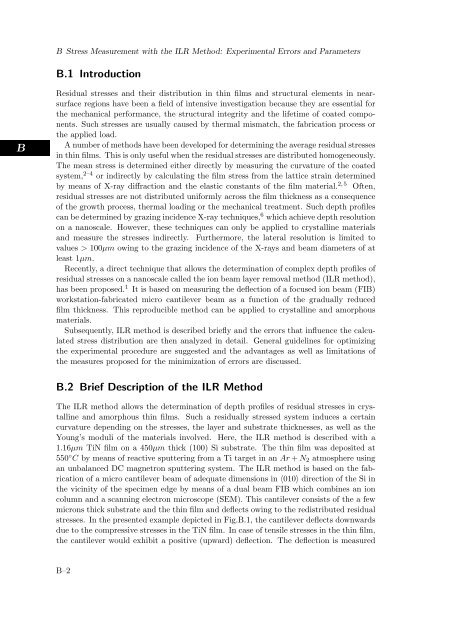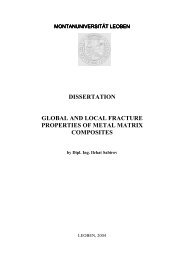1 - Erich Schmid Institute
1 - Erich Schmid Institute
1 - Erich Schmid Institute
Create successful ePaper yourself
Turn your PDF publications into a flip-book with our unique Google optimized e-Paper software.
B<br />
B Stress Measurement with the ILR Method: Experimental Errors and Parameters<br />
B.1 Introduction<br />
Residual stresses and their distribution in thin films and structural elements in nearsurface<br />
regions have been a field of intensive investigation because they are essential for<br />
the mechanical performance, the structural integrity and the lifetime of coated components.<br />
Such stresses are usually caused by thermal mismatch, the fabrication process or<br />
the applied load.<br />
A number of methods have been developed for determining the average residual stresses<br />
in thin films. This is only useful when the residual stresses are distributed homogeneously.<br />
The mean stress is determined either directly by measuring the curvature of the coated<br />
system, 2–4 or indirectly by calculating the film stress from the lattice strain determined<br />
by means of X-ray diffraction and the elastic constants of the film material. 2, 5 Often,<br />
residual stresses are not distributed uniformly across the film thickness as a consequence<br />
of the growth process, thermal loading or the mechanical treatment. Such depth profiles<br />
can be determined by grazing incidence X-ray techniques, 6 which achieve depth resolution<br />
on a nanoscale. However, these techniques can only be applied to crystalline materials<br />
and measure the stresses indirectly. Furthermore, the lateral resolution is limited to<br />
values > 100µm owing to the grazing incidence of the X-rays and beam diameters of at<br />
least 1µm.<br />
Recently, a direct technique that allows the determination of complex depth profiles of<br />
residual stresses on a nanoscale called the ion beam layer removal method (ILR method),<br />
has been proposed. 1 It is based on measuring the deflection of a focused ion beam (FIB)<br />
workstation-fabricated micro cantilever beam as a function of the gradually reduced<br />
film thickness. This reproducible method can be applied to crystalline and amorphous<br />
materials.<br />
Subsequently, ILR method is described briefly and the errors that influence the calculated<br />
stress distribution are then analyzed in detail. General guidelines for optimizing<br />
the experimental procedure are suggested and the advantages as well as limitations of<br />
the measures proposed for the minimization of errors are discussed.<br />
B.2 Brief Description of the ILR Method<br />
The ILR method allows the determination of depth profiles of residual stresses in crystalline<br />
and amorphous thin films. Such a residually stressed system induces a certain<br />
curvature depending on the stresses, the layer and substrate thicknesses, as well as the<br />
Young’s moduli of the materials involved. Here, the ILR method is described with a<br />
1.16µm TiN film on a 450µm thick (100) Si substrate. The thin film was deposited at<br />
550 ◦ C by means of reactive sputtering from a Ti target in an Ar + N2 atmosphere using<br />
an unbalanced DC magnetron sputtering system. The ILR method is based on the fabrication<br />
of a micro cantilever beam of adequate dimensions in 〈010〉 direction of the Si in<br />
the vicinity of the specimen edge by means of a dual beam FIB which combines an ion<br />
column and a scanning electron microscope (SEM). This cantilever consists of the a few<br />
microns thick substrate and the thin film and deflects owing to the redistributed residual<br />
stresses. In the presented example depicted in Fig.B.1, the cantilever deflects downwards<br />
due to the compressive stresses in the TiN film. In case of tensile stresses in the thin film,<br />
the cantilever would exhibit a positive (upward) deflection. The deflection is measured<br />
B–2
















